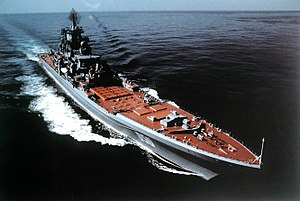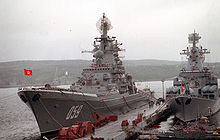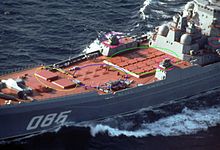Kirov-class battlecruiser
 From Wikipedia - Reading time: 14 min
From Wikipedia - Reading time: 14 min
 Kirov-class battlecruiser Frunze
| |
| Class overview | |
|---|---|
| Name | Kirov class |
| Builders | Baltic Shipyard, Leningrad |
| Operators | |
| Preceded by | Kara class |
| Succeeded by | Lider class |
| Built | 1974–1998 |
| In service | 1980–present |
| Planned | 5 |
| Completed | 4 |
| Cancelled | 1 |
| Active | 1 (1 undergoing refit) |
| Retired | 2 |
| General characteristics | |
| Type | Heavy guided-missile cruiser/battlecruiser |
| Displacement |
|
| Length | 252 m (827 ft) |
| Beam | 28.5 m (94 ft) |
| Draft | 9.1 m (30 ft) |
| Propulsion |
|
| Speed | 32 knots (59 km/h; 37 mph) |
| Range |
|
| Complement | 710 |
| Sensors and processing systems |
|
| Electronic warfare & decoys | 2 × PK-2 Decoy dispensers (400 rockets) |
| Armament |
|
| Armour | 76 mm plating around reactor compartment, light splinter protection |
| Aircraft carried | 3 helicopters |
| Aviation facilities | Below-deck hangar |
The Kirov class, Soviet designation Project 1144 Orlan (Russian: Орлан, lit. 'sea eagle'), is a class of nuclear-powered guided-missile heavy cruisers of the Soviet Navy and Russian Navy, the largest and heaviest surface combatant warships (i.e. not an aircraft carrier or amphibious assault ship) in operation in the world. Among modern warships, they are second in size only to large aircraft carriers; they are similar in size to a World War I-era battleship. Defence commentators in the West often refer to these ships as battlecruisers – due to their size and general appearance.[3] The Soviet classification of the ship-type is "heavy nuclear-powered guided-missile cruiser" (Russian: тяжёлый атомный ракетный крейсер).
The appearance of the Kirov class (first exemplar commissioned in 1979) played a key role in the recommissioning of the Iowa-class battleships by the United States Navy in the 1980s.[4][5][6]
The Kirov class hull-design was also used for the Soviet nuclear-powered command and control ship SSV-33 Ural.
History
[edit]Originally built for the Soviet Navy, the class is named after the first of a series of four ships constructed, Admiral Ushakov, named Kirov until 1992. Original plans called for construction of five ships. The fifth vessel was planned to be named Fleet Admiral of the Soviet Union Kuznetsov, also referred as Dzerzhinsky.[7] The name was later changed to Oktyabrskaya Revolutsiya (October Revolution),[8] and then just Kuznetsov;[9] but on 4 October 1990, plans for construction of a fifth vessel were abandoned.[7]
The lead ship of the class, Kirov, was laid down in March 1974 at Leningrad's Baltiysky Naval Shipyard, launched on 27 December 1977 and commissioned on 30 December 1980. When she appeared for the first time, NATO observers called her BALCOM I (Baltic Combatant I). Kirov suffered a reactor accident in 1990 during her second deployment, which was in the Mediterranean Sea. Repairs were never carried out due to lack of funds and the changing political situation in the Soviet Union, and she was placed in reserve where she was renamed Admiral Ushakov in 1992.[10] She is presently laid up and was slated to be scrapped in 2021.
Frunze, the second vessel in the class, was commissioned in 1984. She was assigned to the Pacific Fleet. In 1992, she was renamed Admiral Lazarev. The ship became inactive in 1994 and was decommissioned four years later. On 21 February 2021, the Russian Armed Forces and the Russian State Atomic Energy Corporation Rosatom, signed a contract to dismantle and scrap the nuclear powered heavy cruiser. Admiral Lazarev set sail 30 April 2021 for 30th Shipyard. Dismantlement should be completed by 30 November 2025.[11]
Kalinin, now Admiral Nakhimov, was the third ship to enter service, in 1988. She was also assigned to the Northern Fleet. Renamed Admiral Nakhimov in 1992, she was mothballed in 1999 and reactivated in 2005. She is undergoing overhaul and modernization at Severodvinsk Shipyard.
Construction of the fourth ship, Yuriy Andropov, encountered many delays; her construction was started in 1986 but was not commissioned until 1998. She was renamed Pyotr Veliky (after Peter the Great) in 1992.[7] She currently serves as the flagship of Russia's Northern Fleet.
In 1983, a command and control ship, SSV-33 Ural, was launched, although the ship would not be officially commissioned until 1989. She utilized the basic hull design of the Kirov-class vessels, but with a modified superstructure, different armament, and was intended for a different role within the Soviet Navy. Ural was decommissioned and laid up in 2001, due to high operating costs, and scrapped starting in 2010.
On 23 March 2004, English language press reported the Russian Navy Commander-in-Chief, Fleet Admiral Vladimir Kuroedov said Pyotr Veliky's reactor was in an extremely bad condition and could explode "at any moment", a statement which may have been the result of internal politics within the Russian Navy.[12] The ship was sent to port for a month, and the crew lost one-third of their pay.
Russia initially planned to reactivate Admiral Ushakov and Admiral Lazarev by 2020,[2][13] but it was later indicated that the condition of the reactor cores of both ships was such that it would prove difficult, expensive and potentially dangerous to remove the spent nuclear fuel and repair the cores. As a consequence, both ships were earmarked for scrapping in 2021.[14] The scrapping of Admiral Lazarev began in early 2021.[15]
As of early 2022, only Pyotr Velikiy was operational. Modernization of Admiral Nakhimov is ongoing and was reported, in 2021, to continue until "at least" 2023,[16] with the modernization of Pyotr Velikiy to immediately follow and last for about three years.[17][18] However, in early 2022, Sevmash CEO Mikhail Budnichenko stated that the ship would be delivered to the Russian Navy in 2022. This deadline would also be missed, and Sevmash later clarified that they expected to return the ship to service in 2024.[19]
The modernization of Admiral Nakhimov and her sister ship is to be extensive, with Admiral Nakhimov expected to receive 174 Vertical-launch (VLS) tubes: 80 for anti-surface and 94 for anti-air warfare, among other upgrades.[20] In early 2022, the Sevmash CEO noted that weapons systems for Admiral Nakhimov would include: the Fort-M (NATO reporting name: SA-N-6 Grumble) and Pantsyr-M (SA-22 Greyhound) air defense systems and Paket-NK and Otvet antisubmarine warfare weapons. It was also reported that the cruiser would potentially be armed with up to 60 3M22 Zircon hypersonic anti-ship missiles.[21]
Design
[edit]The class was originally conceived to counter the U.S. Navy's submarines with its large payload of SS-N-14 anti-submarine missiles, and later evolved to carry twenty P-700 Granit anti-ship missiles for countering the U.S. carrier strike groups. Ultimately the class were intended to operate alongside new nuclear-powered aircraft carriers for global power projection, however these carriers never came to fruition.[22][23]
Weapon systems
[edit]
The Kirov class's main weapons are 20 P-700 Granit (SS-N-19 Shipwreck) missiles mounted in deck, designed to engage large surface targets. Air defense is provided by twelve octuple S-300F launchers with 96 missiles and a pair of Osa-MA batteries with 20 missiles each. Pyotr Velikiy carries some S-300FM missiles and is the only ship in the Russian Navy capable of ballistic missile defence.[2] The ships had some differences in sensor and weapons suites: Kirov came with Metel anti-submarine warfare (ASW) missiles, while on subsequent ships these were replaced with 3K95 Kinzhal (Russian: Кинжал – dagger) surface-to-air missile (SAM) systems. The Kinzhal installation is in fact mounted further forward of the old SS-N-14 mounting, in the structure directly behind the blast shield for the bow mounted RBU ASW rocket launcher. Kirov and Frunze had eight 30 mm (1.18 in) AK-630 close-in weapon systems, which were supplanted with the Kortik air-defence system on later ships.
Other weapons are the automatic 130 mm (5 in) AK-130 gun system (except in Kirov which had two single 100 mm (4 in) guns instead), 10 21-inch (533 mm) torpedo/missile tubes (capable of firing RPK-2 Vyuga ASW missiles on later ships) and Udav-1 with 40 anti-submarine rockets and two sextuple RBU-1000 launchers.
Russia is developing a new anti-ship missile to equip Kirovs called the 3M22 Tsirkon, which is capable of traveling at hypersonic speeds out to at least 620 mi (540 nmi; 1,000 km).[24][25]
Armaments
[edit]| Kirov / Admiral Ushakov | Frunze / Admiral Lazarev | Kalinin / Admiral Nakhimov | Yuri Andropov / Pyotr Velikiy | |
|---|---|---|---|---|
| Anti-ship missiles | 20 x P-700 Granit (SS-N-19 'Shipwreck') | |||
| Anti-submarine missiles | 1 x twin RPK-3 Metel (SS-N-14 'Silex') | |||
| RPK-2 Vyuga (SS-N-15 'Starfish') launched via 533 mm torpedo tube | ||||
| Surface-to-air missiles | 12 × 8 S-300F (SA-N-6 'Grumble') | 6 × 8 S-300F (SA-N-6 'Grumble') | ||
| 2 x 20 9K33 Osa (SA-N-4 'Gecko') | 6 × 8 S-300FM (SA-N-20 'Gargoyle') | |||
| Space reserved for 16 x 8. Only installed on Pyotr Veiliky (8 x 8) 3K95 Kinzhal (SA-N-9 'Gauntlet') | ||||
| Guns | 2 × 1 AK-100 100 mm | 1 × 2 AK-130 130 mm | ||
| close-in weapon systems | 8 x AK-630 | 6 x CADS-N-1 | ||
| Anti-submarine rockets | 2 x RBU-1000, 1 x RBU-12000 | |||
| Torpedo tubes | 10 x 533mm torpedo tubes for Type 53 | |||
Fire control
[edit]

- 2 × Top Dome for S-300F fire control radar (the forward Top Dome is replaced with Tomb Stone (Passive electronically scanned array) in Pyotr Veliky)
- 4 × Bass Tilt for AK-630 CIWS System fire control (not in Admiral Nakhimov or Pyotr Veliky)
- 2 × Eye Bowl for OSA-M fire control (also for SS-N-14 in Admiral Ushakov)
- 2 × Hot Flash/Hot Spot for Kortik (CADS-N-1 units only)
- 1 × Kite Screech for AK-100 or AK-130
- 2 × Cross Sword for Kinzhal (Kinzhal-equipped units only)
Combined nuclear and steam propulsion
[edit]| Combined marine propulsion |
|---|
|
Combined diesel or gas (CODOG) |
Combined nuclear and steam propulsion system (CONAS) is used on the Kirov battlecruisers. Complementary to the nuclear component, there are two conventional boilers installed as a backup in case of reactor failure. Both components can drive two geared steam turbines, generating 120,000 hp (89 MW), at two prop shafts.[26]
Ships
[edit]| Name | Namesake | Builder | Laid down | Launched | Commissioned | Status |
|---|---|---|---|---|---|---|
| Admiral Ushakov (ex-Kirov) |
Fyodor Ushakov | Baltiysky Zavod, Leningrad | 27 March 1974 | 26 December 1977 | 30 December 1980 | Laid up, to be scrapped in 2021[14] |
| Admiral Lazarev (ex-Frunze) |
Mikhail Lazarev | 27 July 1978 | 26 May 1981 | 31 October 1984 | Scrapping commenced April 2021[27] | |
| Admiral Nakhimov (ex-Kalinin) |
Pavel Nakhimov | 17 May 1983 | 25 April 1986 | 30 December 1988 | Mothballed in 1999. Modernisation started in 2015.[28] Due to return to service in 2024.[29] | |
| Pyotr Velikiy (ex-Yuriy Andropov) |
Peter the Great | 11 March 1986 | 29 April 1989 | 9 April 1998 | In service with the Northern Fleet | |
| Admiral Flota Sovetskogo Soyuza Kuznetsov (ex-Dzerzhinsky, ex-Oktyabrskaya Revolutsiya) |
Nikolay Gerasimovich Kuznetsov | Cancelled, 4 October 1990 | ||||
-
The Russian flagship Pyotr Veliky
-
Kirov at anchor
-
The flight deck of Kalinin showing the hangar doors open and a Kamov Ka-25 and a Kamov Ka-27 helicopter
See also
[edit]- List of naval ship classes in service
- List of active Russian Navy ships
- List of ships of Russia by project number
- List of ships of the Soviet Navy
- Kirov-class cruiser
References
[edit]- ^ "Kirov (Orlan) Class (Type 1144.1/1144.2) (CGN)". Jane's. 8 September 2000. Archived from the original on 15 April 2009.
- ^ a b c d e "Russian Warship Tests Missile Defense Capability". RIA Novosti. 20 September 2012. Archived from the original on 22 September 2012. Retrieved 28 September 2012.
- ^ Armi da guerra, De Agostini, Novara, 1985.
- ^ Middleton, Drew (13 March 1981). "Pentagon likes budget proposal, but questions specifics". The New York Times. p. A14.
- ^ Bishop, p. 80.
- ^ Miller & Miller, p. 114.
- ^ a b c Апалков, Ю.В. (2003). Ударные корабли, Том II, часть I (in Russian). Санкт-Петербург: Галея Принт.
- ^ Pike, John (19 March 2012). "Kirov Class – Project 1144.2". GlobalSecurity.org. Archived from the original on 22 February 2014. Retrieved 9 February 2014.
- ^ Pike, John. "Kirov Class – Project 1144.2". GlobalSecurity.org. Archived from the original on 22 February 2014. Retrieved 9 February 2014.
- ^ "Russia is Trying to Restore a Giant Nuclear Battlecruiser—It's Not Working Out". Forbes.
- ^ White, Ryan (21 February 2021). "Russia to scrap nuclear battlecruiser Admiral Lazarev". Naval Post. Retrieved 13 October 2021.
- ^ Digges, Charles (23 March 2004). "Kuroyedov declares 'Peter the Great' could explode 'at any moment'". Bellona. Archived from the original on 29 September 2011. Retrieved 28 December 2011.
- ^ "Upgraded Nuclear Cruiser to Rejoin Russian Navy in 2018". RIA Novosti. 13 June 2013. Archived from the original on 15 June 2013. Retrieved 9 February 2014.
- ^ "Карточка контракта № 1770641334821000012: Утилизация тяжелого атомного ракетного крейсера "Адмирал Лазарев" проекта 1144.1 заводской № 801" [Contract card No. 1770641334821000012: Disposal of the heavy nuclear missile cruiser "Admiral Lazarev" of project 1144.1 serial number 801]. Federal Treasury (in Russian). Archived from the original on 4 May 2021. Retrieved 21 February 2021.
- ^ "Handover of Admiral Nakhimov battlecruiser to Russian navy postponed – source". TASS. 7 April 2021.
- ^ "Russia's flagship nuclear battle cruiser – the world's largest – puts in for repairs". Bellona.org. 9 September 2015. Archived from the original on 14 March 2016. Retrieved 13 March 2016.
- ^ "This Deadly Russian Warship Is the Closest Thing to a Battleship Sailing Today". The National Interest. 20 February 2019. Archived from the original on 1 May 2019. Retrieved 1 May 2019.
- ^ Новости, Р. И. А. (27 February 2023). "Атомный ракетный крейсер "Адмирал Нахимов" вернется на флот в 2024 году". РИА Новости (in Russian). Retrieved 5 January 2024.
- ^ madeinrussia. "Admiral Nakhimov modernization. February 2020". Retrieved 17 May 2020 – via Facebook.
- ^ "Russia's Sevmash Shipyard Says it Will Deliver Admiral Nakhimov in 2022". 18 February 2022.
- ^ "The National Interest: Blog".
- ^ "Russia's navy has big plans for its Soviet-era battlecruisers". Business Insider.
- ^ "Ракеты "Циркон" окончательно определили технологическое превосходство России над США" [The "Zircon" missiles definitively determine Russia's technological superiority over the United States]. Ruspolitica.ru (in Russian). 28 October 2016. Archived from the original on 10 June 2017. Retrieved 18 June 2017.
- ^ "Для гиперзвуковых крылатых ракет в России создано принципиально новое топливо" [A fundamentally new fuel has been created in Russia for hypersonic cruise missiles]. vesti.ru (in Russian). 17 March 2016. Archived from the original on 29 May 2017. Retrieved 25 May 2017.
- ^ V.P. Kuzin, "Type 1144 Nuclear Guided Missile Cruisers", "Typhoon" almanac, 1-4 1999 Archived 2007-11-23 at the Wayback Machine
- ^ @seawaves_mag (30 April 2021). "Project 1144 Admiral Lazarev departed Strelok Bay today for the breakers" (Tweet). Retrieved 1 May 2021 – via Twitter.
- ^ "Russian Shipyard Sevmash Ordered New Equipment for Overhaul of Kirov Class Cruiser Nakhimov". Navyrecognition.com. 6 January 2015. Archived from the original on 12 February 2015. Retrieved 12 February 2015.
- ^ Brahy, Jérôme. "Russian nuclear battlecruiser Admiral Nakhimov to begin sea trials in November with new hypersonic missiles". armyrecognition.com. Retrieved 6 July 2024.
Sources
[edit]- Bishop, Chris (1988). The Encyclopedia of World Sea Power. New York: Crescent Books. ISBN 978-0-517-65342-5. OCLC 18199237.
- Miller, David; Chris Miller (1986). Modern Naval Combat. London: Salamander Books. ISBN 978-0-86101-231-2. OCLC 17397400.
External links
[edit]- Illustrated article about the Kirov class
- Globalsecurity.org page on Kirov class
- Kirov class photos from Mark Meredith
- Encyclopedia of ships (in Russian)
- Military Reform Support Fund Archived 14 August 2008 at the Wayback Machine (in Russian)
- Forum discussion of ships' armament (in Russian)
- FAS.org article Archived 7 September 2008 at the Wayback Machine
- Project 1144 – Complete Ship List
 KSF
KSF



